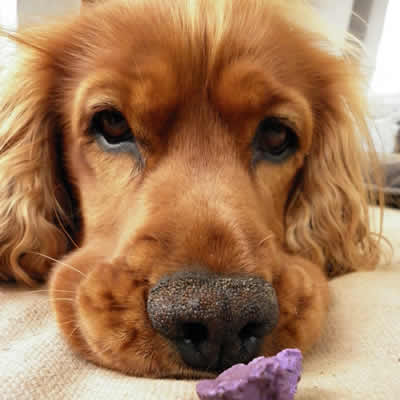The medical history (Anaplasmosis in dogs) of Jacko, a 4 year old cocker spaniel with 14 kg body weight, reads like a tragedy. Jacko was lucky, because his owner, became aware early on about the possibility of anaplasmosis in dogs because a friend knew about Lyme disease and other tick-borne diseases.
Jacko lives close to the edge of the forest. He is treated every 4 weeks with a tick protection of the latest Generation. 
In addition, he is examined daily for moving ticks, not firmly engorged ticks likely to move on to the people in the environment of pets. The dog owner is suffering from a chronic persistent Lyme disease and has notified us about the danger posed by tick-borne infections and sent us the case history of her dog for publication.
Introduction to Jacko’s history
It is often claimed that the anaplasmosis in dogs is – just like the Lyme disease – in Germany, hardly occurring and a disease that can be treated easily. My internet research has revealed a very different prognosis for Jacko. We can read that the chances of survival in most dogs is almost zero, because the disease is not diagnosed initally, and the animal is then treated wrongly or insufficiently.
Thanks to a friend who had access to doxycycline monohydrate from human medicine, I could treat Jacko until the symptoms had almost completely regressed.  Anaplasmosis & Lyme disease are frequently found in our area, but dog owners generally do not have access to dignosis and treatments like Doxycycline or Carbesia.
Anaplasmosis & Lyme disease are frequently found in our area, but dog owners generally do not have access to dignosis and treatments like Doxycycline or Carbesia.
They had lab reports confirming that their dogs have anaplasmosis, and they made 5 copies of the lab report and visited 5 different vets to ensure treatment for their dogs.
There was almost complete reversal of the symptoms.
Jacko’s medical history (Anaplasmosis in dogs):
From the beginning of July 2012 recurring gloomy mood, pain, limping at intervals.
13.07.2012 Hip and hind legs touch sensitive, particularly limping on the right side. Gums white (thrombocytopenia = decrease in blood platelets).
31.07.2012 Anaplasmosis diagnosed at a value 1:1000, a test is negative at a value 1:50.
02.08.2012 beginning of antibiotic therapy with doxycycline monohydrate 100mg tablets 2 times daily (1 tablet every 12 hours).
07.08.2012 Left lip hangs, drooling, mood, however, improved significantly.
08.08.2012 Drooling, swollen eyes, nystagmus (uncontrollable, rhythmic movements of the eyes) with twitching of the right eyelid.
09.08.2012 Staggering, he fell 3 feet down the stairs, puffy eyes, fell off of a 1 metre high wall in the afternoon, he was unsteady, dizziness with lowered head posture, cranial nerve involvement – vestibular symptoms.
10.08.2012 Torticollis (skewed position of the head), unsteadiness somewhat reduced, Carbesia (Imidocarb) injection.
11.08.2012 Great exhaustion after a small walk. Equilibrium symptoms improved slightly.
12.08.2012 Balance better, subsided eyelids, twitching of the left eyelid.
13.08.2012 Vomiting, lips/tongue not working properly – food falls from the muzzle, and balls can not be retrieved despite playful mood. In the field of general well-being already 70% improvement.
14.08.2012 80% improvement, unsteadiness and nystagmus again in the evening.
15.08.2012 90% improvement in the general condition, rare unsteadiness, nystagmus after exertion.
16.08.2012 Unsteadiness with vertigo, right eye twitching, improvement of symptoms remains at about 80%.
17.08.2012 Good appetite with 90% improvement.
21.08.2012 He wants to play, but the paws pull reciprocally high – pain symptoms.
22.08.2012 All day in deep sleep.
23 – 24.08.2012 Unsteadiness on both sides with dizziness and pain symptoms of paws front and hind legs.
24.08.2012 Carbesia injection.
24 – 31.08.2012 Torticollis, fatigue, gait disturbance, acts disoriented, Nystagmus.
03.09.2012 Torticollis throughout with new-onset head tremor, appetite better, gums and tongue are pink again.
3.09.- 11.09.2012 Head posture permanently wrong, nystagmus, mood excited, barks more than usual.
11.- 20.09.2012 Retires, extremely prolonged sleep phase, position of the head wrong, occasional head tremor.
21.- 24.09.2012 General improvement, looks much healthier.
24.09.2012 Staggers again, nystagmus, lip clamped between his teeth, appears to have sensory disturbances.
26.09.2012 Increasing the dose of doxycycline monohydrate 100mg tablets. 100mg in the morning and 200mg in the evening.
27.09.2012 General improvement, shaking his head, as if a foreign body in the ear.
29.09.2012 Increasing the dose of doxycycline monohydrate 100mg tablets. 200mg in the morning and 200mg in the evening.
29.09.- 02.10.2012 Limping front leg.
04.- 15.10.2012 Good mood, playful.
15.10.- 20.10.2012 Appears very tired.
From 21.10.2012 apparent resolution of symptoms.
24.10.2012 Last dose doxycycline Monohydrate.
18.02.2013 Once more again head shaking and scratching, stiff gait – as if rusty. Twice daily Doxycycline Monohydrate 100mg tablets until 04.09.2013.
07.10.2013 Scabs all over his body, bleeding easily. Tired and floppy, listless. Re-treatment with twice daily Doxycycline Monohydrate 100mg until 07.08.2013, increasing of the dosage, 3 times (means every 8 hours) 100 mg daily after the 11th day of treating.
24.06.2014 Depressive mood, limping with hind legs, slightly colourless gums. Treatment with 2 doses Doxycycline Monohydrate 100mg daily. Treating a total of 40 days until 30.07.2014.
07.08.2014 Carbesia injection. Significant improvement in the all of the symptoms!
22.07.2014 Second Carbesia injection after the interval of 14 days. Almost one year Symptom free.
Complaint free period, once again lively and playful.
20.05.2015 Three ticks despite regular treatment with Advantix. Clearly visible fatigue, limping and stumbling over the front paws.
20.05.2015 Start treatment with Doxycycline Monohydrate 100 mg twice daily for 25 days. Improvement of paws symptoms after about 4 days, fatigue decreases.
06.06.2015 and 30.062015 respectively, Carbesia injection.
28.06.2015 Tick on the left side of his face, probably 2-3 hours sucking.
02.07.2015 Again limping and stumbling over his forepaws, grumpy mood. Immediate start with dosage of Doxycycline Monohydrate 100mg twice daily. Treatment currently ongoing.
2015 Some 27 ticks were found despite regular use of Advantix.
26.11.2015 He was limping and tripping over the front paws and had exhaustion. Immediate start with Doxycycline monohydrate 100mg with twice daily doses. Therapy over forty-four days with Carbesia injections because of the unsteadiness of the gait during the first weeks of therapy.
End of January 2016 therapy ended.
23.08.2016 new relapsing of Anaplasmosis was treated with 40 days Doxycyclin monohydrate 100mg twice a day, because in the middle of the therapy cycle new tick contact had taken place.
From 15.01.2017 Jacko again showed the usual anaplasmosis symptoms. This time he was given 34 days of therapy with Doxycycline monohydrate 100mg twice a day. Subsequently, Jacko showed no symptoms of Anaplasmosis until May, but broke his shoulder joint. As a result of the trauma and surgery, the typical symptoms of Anaplasmosis were evident.
On 14.06.2017 He started renewed therapy with Doxycycline monohydrate 100mg twice a day for 25 days.
In early December 2017, Jacko showed increasing symptoms of Anaplasmosis with lens opacification in both eyes.
From 23.12.2017 New therapy cycle was started with Doxycycline monohydrate 100mg twice a day for 33 days. In the course of the therapy, the lens opacity returned.


Ein Kommentar
Poor baby. How is Jacko doing now? I am assuming that this is a dog that was treated in Germany. How come that no other treatment was suggested or implemented? My dog has Anaplasmosis as well, and we are exploring other options trying to eradicate this infection. There has been lots of chitter chatter about other antibiotics that are supposed to completely destroy the bacteria. I am hopeful, because this is very frustrating when the symptoms are all over the place, local veterinarians don’t know where to start and what to treat first, and also seem to not care to dive into exploring other possibilities.